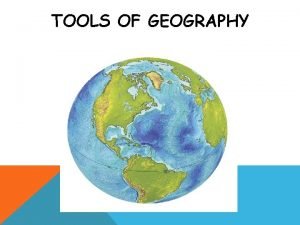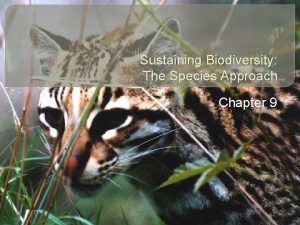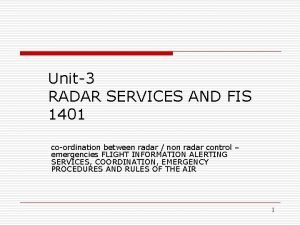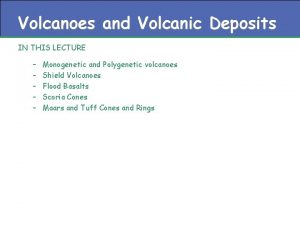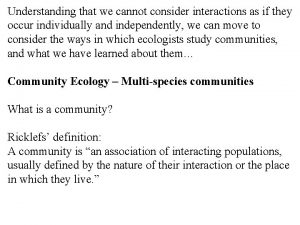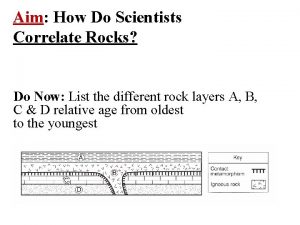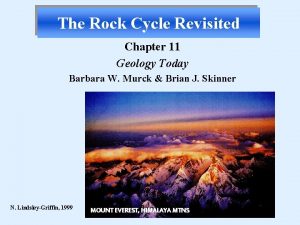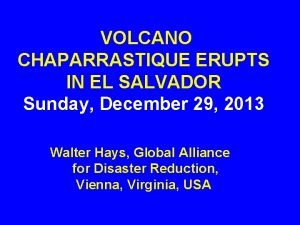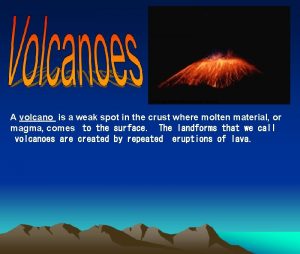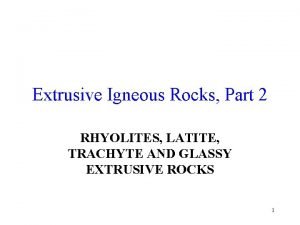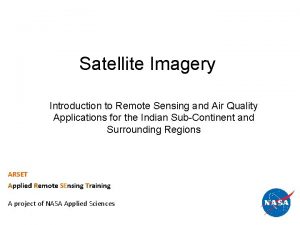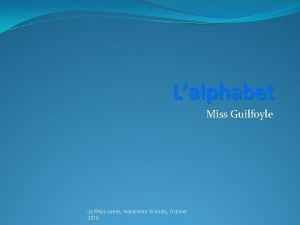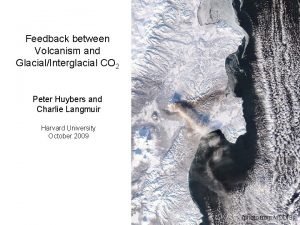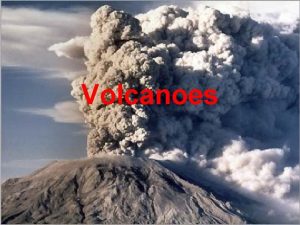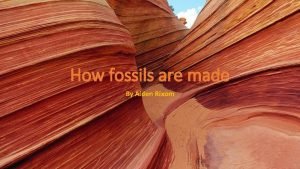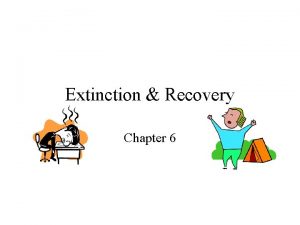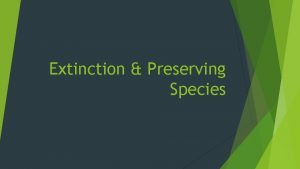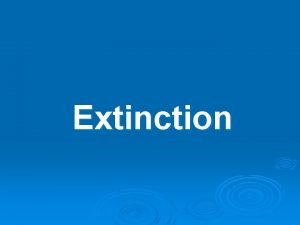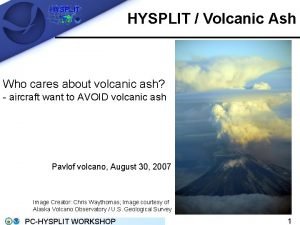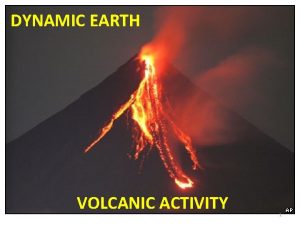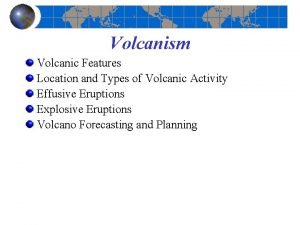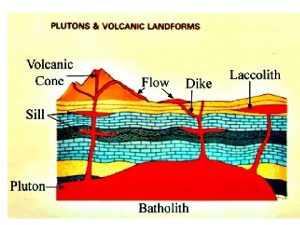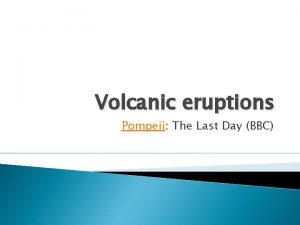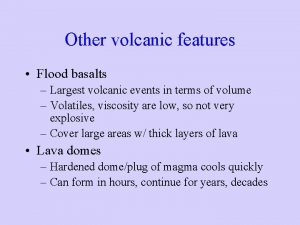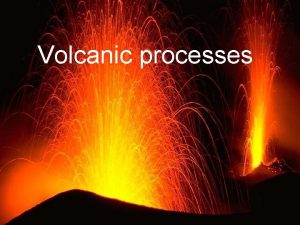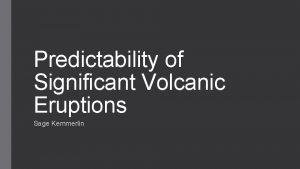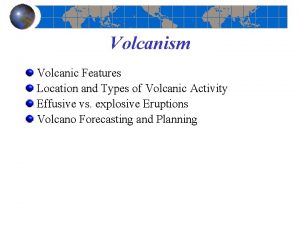Causes of Extinction Nonhuman causes of extinction Volcanic





















- Slides: 21

Causes of Extinction

Non-human causes of extinction: • • Volcanic events Ocean temperature change Sea level changes Meteorites Glaciations Global climate change Competition/predation

Human causes of extinction/loss of biodiversity - HIPPO • Habitat destruction and fragmentation • Introduced species • Pollution • Population • Over consumption

Rates of Extinction: = number of species becoming extinct per unit time. • Rates of extinction are very difficult to estimate, because we don't even know within an order of magnitude how many species there are. • Fossil records can reveal the average "lifetimes" of species, or how long different classes of plants and animals generally exist on the earth

• From this information, scientists can determine a "background" rate of extinction, or the natural rate of extinction without human intervention. • Because of human intervention the Earth's species are dying out at an alarming rate, up to 1, 000 times faster than their natural rate of extinction.

• By carefully examining fossil records and ecosystem destruction, some scientists estimate that as many as 137 species disappear from the Earth EACH DAY, which adds up to an astounding 50, 000 species disappearing every year.

The Earth has experienced 5 MASS EXTINC

• Mammals average species lifespan 1 million years. • With ~ 5, 000 mammalian species the background extinction rate = 1 every 200 years. • In the past 400 years, though, 89 extinctions have been recorded, almost 45 times the natural rate. • Over 50 of those extinctions have occurred in the past century, • Rate = 100 times the background rate!!

Extinction Rates over geological time

Red List Criteria The World Conservation Union (IUCN) Red List Criteria are used to determine extinction risk and set numerical thresholds for qualification for three globally threatened categories. http: //www. youtube. com/watch? v=F 7 Xk. Uzi. Ftlc 2: 43

The Niche • A niche is a species way of life. A niche is the role that the species plays in the environment that it lives in. • Niche includes: 1. range of conditions that the species can tolerate 2. methods by which the species can obtain the needed resources 3. number of offspring 4. time of reproduction 5. all of the species other interactions with its environment

Specific aims: • To provide a system that can be applied consistently by different people. • To improve objectivity by providing users with clear guidance on how to evaluate different factors which affect the risk of extinction. • To provide a system which will facilitate comparisons across widely different taxa. • To give people using the threatened species lists a better understanding of how individual species were classified.

Categories • EXTINCT (Ex) - taxa for which there is no reasonable doubt that the last individual has died. After exhaustive surveys in known and/or expected habitat, at appropriate times, throughout its historic range. • ENDANGERED (E) – taxa in danger of extinction and whose survival is unlikely if the casual factors continue operating. Include taxa with drastically reduced numbers and habitats.

• Vulnerable (V) – taxa believed to move into endangered category in the near future if the factors causing decline continue operating (overexploitation, habitat destruction, other environmental disturbance, numbers are abundant but are under threat from serious adverse factors). • Rare (R) – taxa with small world populations that are not at present endangered or vulnerable, but are a risk as some unexpected threat could easily cause a critical decline (usually small geographic distribution).

• Unknown (K) – taxa that are suspected but not definitely known to belong to any of the categories because of lack of information.

• Essay – for a named species describe its physical characteristics, niche, and Red List status, and why you personally would be upset if it were to become extinct.

IUCN Mission Statement: “to influence, encourage and assist societies throughout the world to conserve the integrity and diversity of nature and to ensure that any use of natural resources is equitable and ecologically sustainable. ”

Case histories of Species and Natural Area

Wood Bison as an example of an endangered species whose conservation status has been improved by intervention.

Wood Bison (WB): • • • • 1800's: 60, 000 total and 168, 000 wood bison (WB) 1889 : 800 total and 550 WB due to hunting (meat and hide) and disease? First protective laws 1877 -93 1925/28 - 6673 diseased plains buffalo (PB) sent to WBNP (Wood Bison National Park) (1922) infected WB and compromised their genetic integrity ie PB X WB; the concern? Are there any "pure" WB 1959/63 - discovery of "pure" WB in WBNP 37 WB are the ancestors of all "pure" WB 1975 -WB Recovery Programme 1977 -International Commercial Trade Prohibited under CITES (Convention on International Trade of Endangered Species) 1979 - classified as "endangered" by COSEWIC (Committee on the Status of Endangered Wildlife in Canada) 1983 - WBNP made a World Heritage Site by UNESCO 1988 - downgraded to "threatened" 1990 - Northern Diseased Bison Environmental Assessment Panel http: //www. youtube. com/watch? v=SZNMj 28 Cbcc

 Emblem
Emblem Tools of geography
Tools of geography What is the study of human and nonhuman features of earth
What is the study of human and nonhuman features of earth Gives human characteristics to nonhuman objects
Gives human characteristics to nonhuman objects Pronoun for human
Pronoun for human Apes chapter 9 sustaining biodiversity
Apes chapter 9 sustaining biodiversity Radar control service
Radar control service What are plutons that cause overlying rocks to bow upward
What are plutons that cause overlying rocks to bow upward Types of volcanoes
Types of volcanoes Volcanic ash
Volcanic ash Whittaker
Whittaker Index fossil
Index fossil Volcanic ash
Volcanic ash Volcanic ash
Volcanic ash Volcanic ash
Volcanic ash Rhyolite
Rhyolite Volcanic ash
Volcanic ash Volcanic ash
Volcanic ash Volcanic features
Volcanic features Volcanic landform
Volcanic landform Michael rixom
Michael rixom Island volcanic arc
Island volcanic arc

